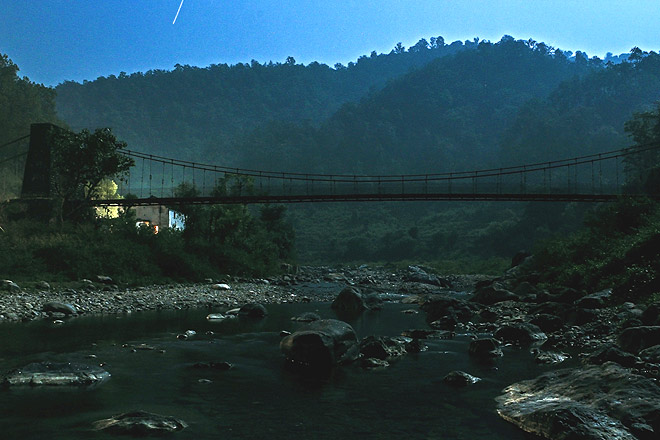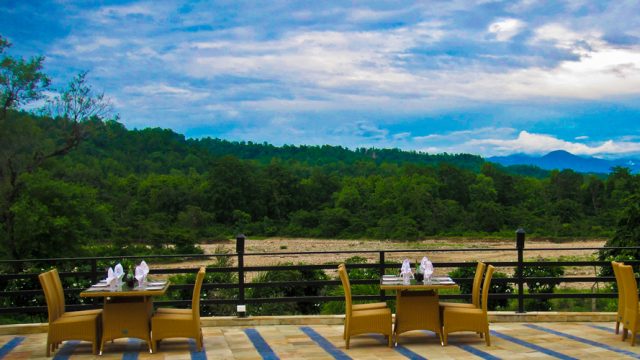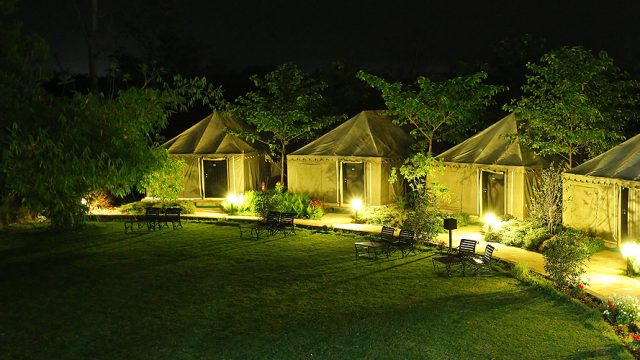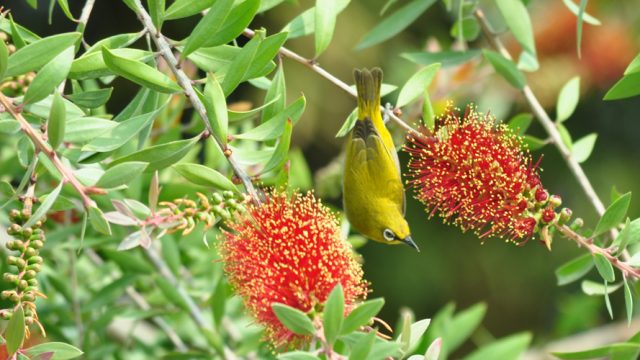Far-flung, non-descript, and picturesque, Rathuwadab seemed like an unmapped destination. It is a little hamlet that rubs
My friend Saumit and I were assigned the task of capturing the character of the place with the help of our cameras and we picked a colonial-era bridge to be the base of our documenting endeavour. Although the bridge itself had been clumsily renovated, the original pillars had been left untouched, maintaining its old-world charm. The bridge and stray lights from the village, against the impressive backdrop of Garhwal’s undulating hills, gave me the frame necessary for aesthetic perfection. To lend an air of mystery to the image, I decided to shoot at night. This was how our troubles began.
Shooting an image at night involves taking a long exposure, which in simple terms means allowing the shutter to stay open for long periods. Ideally it takes about 15-20 minutes of standing by while the camera shoots and then waiting just as long while the camera processes the shot. So at least 40 minutes for one shot, with the proviso that rarely does one get it right in a single attempt.
Little did we know that the words, ‘staying out after dark’ were anathema to the people living here; outdoor activities at night was deemed hazardous to say the least. What the hazard was and why staying outdoors after sunset sounded like a suicidal proposition to them is something neither Saumit nor I could decipher. Seeing us go about our business after sundown, every now and then, a local passerby, thoroughly flustered by our antics would walk up to us and quiz us about our motives. Most of them left even more perplexed than and some even graciously wished us luck.
Being cautious of stray animals from the neighbouring jungles of Corbett is one thing, but being gripped by mass paranoia is another. What puzzled us even more was that apart from an overbearing sense of concern for our safety, the locals divulged nothing. Bemused by their behaviour, but not offering it much thought, I saw no harm in braving the outdoors at night, since a couple of locals agreed to accompany us. But with shaadi-season in full swing, the men we had banked on to escort us back to our lodge, let the revelry get the better of them.
Exhausted and exasperated, my friend and I were left to our own devices and plodded our way back to the lodge. Although the trek was extremely nerve-racking, as any forested trail under the cover of darkness would be, nothing untoward happened. We were still at a loss to explain why the locals were petrified of moving about at night.
A month later we had our answer while flipping through a book written by F.W. Champion—a colonial-era forest officer and a foremost conservationist of his time. A passage described the leopards of Garhwal as being the most bloodthirsty of their kind in the country. Not wanting to jump the gun, I did some research of my own and the statistics painted a horrifying picture—man-leopard conflict in Garhwal killed on an average one person per week; leopard attacks in the region lead to more fatalities than any other part of the country. We were glad to have not added to the figure, and come away unscathed by a whisker’s length.
This wasn’t the last time I unknowingly found myself in a perilous situation while attempting to take a long exposure of a bridge. Just a couple of weeks later, Saumit and I were sprawling on a bridge on the Kosi river, bending and twisting ourselves into awkward postures to find the perfect frame for our shots.
It was barely a stone’s throw away from the southern boundary of Corbett. Tigers frequently crossed over from one side of the river to another, so when a cheetal called to warn its fellow jungle denizens of a tiger on the prowl, we were not surprised. Judging by the definition of the call, the deer was an estimated fifty meters away from us. Born and brought up in the jungles of Corbett, Usman, our driver and guide, felt that the big cat was too far away to pose a risk of any sort. Our work continued without much ado until the cheetal called once again. The call was louder, more distinct and came from a forested trail leading off from the other end of the bridge. This could mean only one thing, the tiger was on the move and it was headed towards the bridge.
We hastily packed our equipment and scampered back to the safety of the jeep. Moments later, Saumit started to scan the bridge with his torch; he thought torch-light was necessary to ascertain if we were being approached by an animal. I was against such a move, as not only did I find it unnecessary but also feared the tiger being driven away. To prove him wrong, I started walking back towards the bridge. But it was frighteningly dark, my bravado failed and I scampered back to the jeep.
Barely a couple of seconds later, Usman asked for the torch as an unusual splashing noise had caught his ear. To me it sounded preposterous; if an animal did splash, the loud gurgling of the river would render it inaudible. But Usman’s instincts were far keener than mine, and they hadn’t let him down; the torchlight fell on the river and two yellowish-white orbs stared back at us. The hypnotic glare of the beast was upon us. We tracked it with the torch till it vanished into the thickets. The meeting was over in a matter of seconds.

The next day I walked back to the site of last night’s drama and what I discovered shocked me profoundly. The forest path leading to the jungle bridge, frequented by the locals in the daytime, featured the semi-obliterated pugmarks of a tiger all the way up to the end of the bridge. In all probability, this could mean only one thing- the tiger and I were on a collision course, when in a bid to prove Saumit wrong, I’d walked to the centre of the bridge. An ugly and possibly fatal encounter had been averted the previous night, when the tiger, irked by my presence, opted for a detour. So much for being the more intelligent species!
tigers
wildlife
Wildlife Photography
Leave a Reply
You must be logged in to post a comment.





